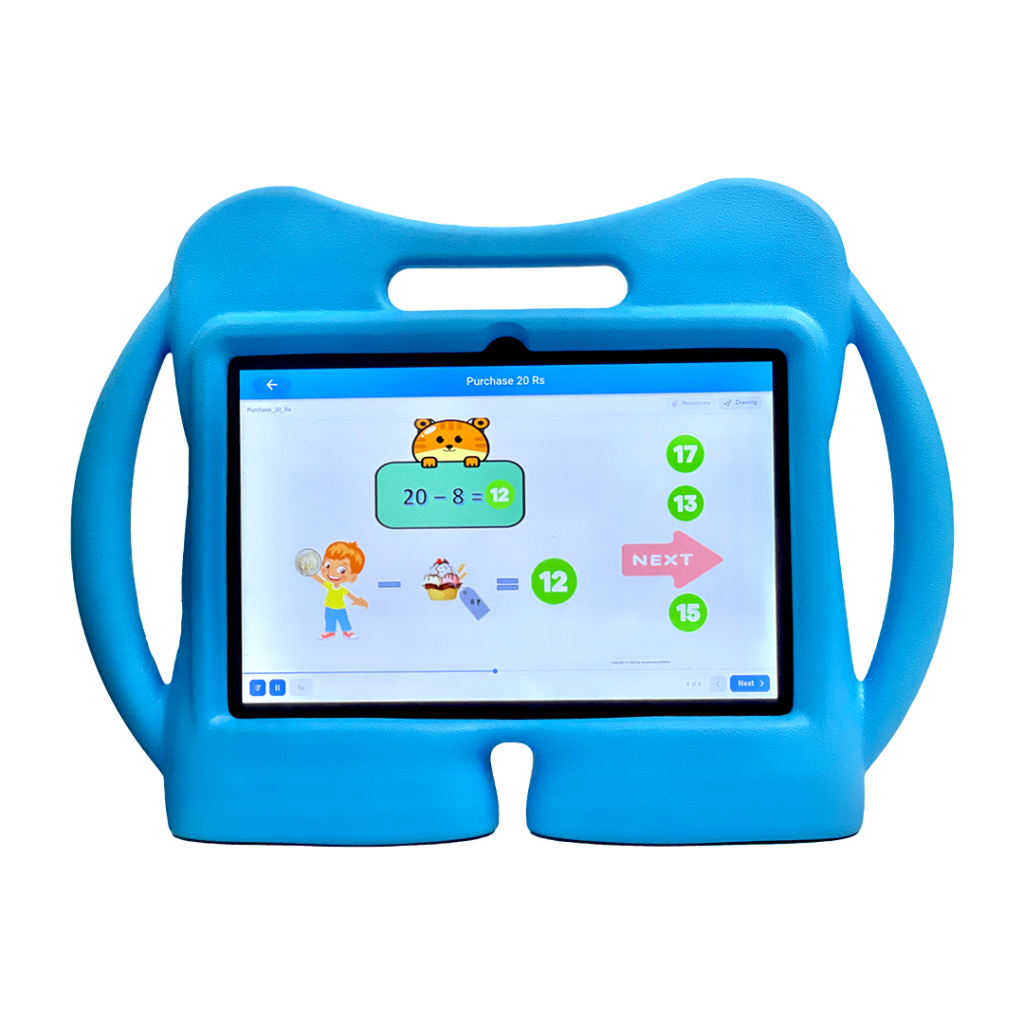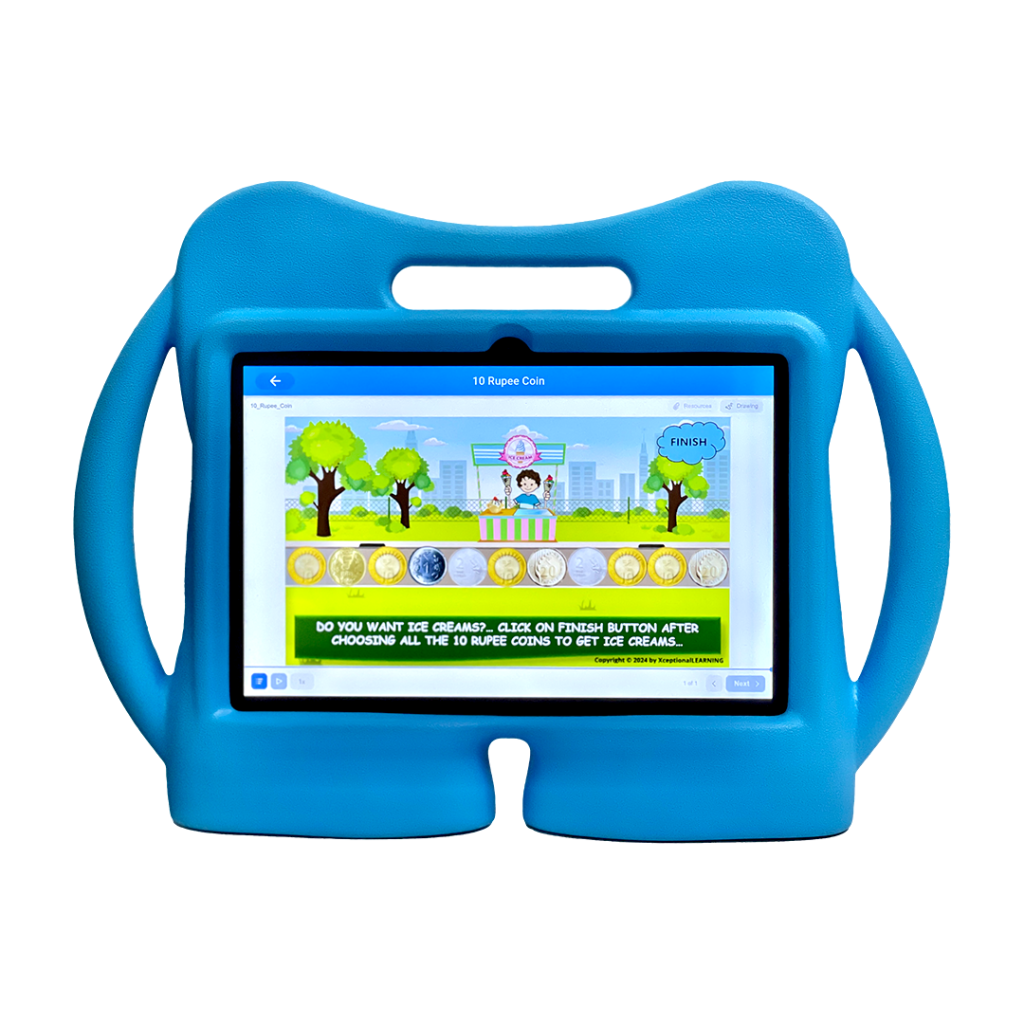
Ever since the inception of the modern school system, one subject that most of us and our children have struggled with time and again might be Mathematics. Most students try for an easy way out, and avoid the subject as soon as elective options come by.
Mathematics can be challenging for any child, but even more so for those in special education. They may require extra time, personalized strategies, and visual support to grasp even the basic concepts. Topics like fractions, estimation, and probability can be particularly tricky, since they go beyond simple counting and require deeper conceptual understanding. However, introducing these concepts in ways that are relatable, visual, and engaging helps children to not only learn them better but also begin to apply them in real-life situations.
Here is where VergeTAB, powered by the XceptionalLEARNING Platform becomes highly relevant and useful. Designed with the unique needs of special education learners in mind, VergeTAB makes these complex functions easy to grasp through interactive visuals, guided steps, and engaging practices.
Why Fractions, Estimation, and Probability Matter in Everyday Life
- Fractions help children break things into portions, whether it’s food, objects, or minutes.
- Estimation helps them make quick decisions like “Do I have enough money to buy this toy?”
- Probability helps them predict outcomes, understand fairness in games, and prepare for everyday choices.
For children in special education, this easier and attractive way of learning paves a smoother way. For them, these lessons go beyond school exams—they build independence, confidence, and real-world problem-solving.
VergeTAB, in addition to making learning an interesting experience in general, turns these seemingly abstract and difficult concepts into visual, interactive experiences that the children look forward to.


Let’s break down these three concepts one by one.
FRACTIONS Made Simpler
Concept Introduction
Fractions can feel confusing because they represent “parts of a whole.” For a child in special education, simply showing numbers like ½ or ¾ is not enough—they need to see, touch, and interact with the idea of splitting something into equal parts.
Scenario / Problem
Imagine a student trying to understand how to share one pizza among four friends. On paper, the division into quarters may look abstract, but in real life, the child needs to visualize the actual slices.
VergeTAB Solution
With VergeTAB, the pizza-sharing scenario becomes interactive. Children can drag visuals of a pizza into equal slices, compare sizes, and even see what happens if pieces are unequal. Step-by-step instructions guide the learner through dividing a whole into fractions. The blank, distraction-free design ensures focus remains on the task without distractions.
Step-by-Step Visual Strategy:
- A pizza image appears on the screen.
- The child taps to divide it into two halves.
- With another tap, the halves divide into four quarters.
- A prompt asks: “If you eat one piece, how many are left?”
- The child selects the answer visually, reinforcing the fraction ¼.
Learning Outcomes / Key Concept
- Builds visual understanding of parts and wholes.
- Reinforces equal vs. unequal sharing.
- Encourages hands-on practice without paper overload.
Interactive Challenges / Practice Question
- A box contains 15 pencils, and 3 students want to share them equally. How many pencils does each student get? Show as a fraction.
- Divide 8 toy blocks among 4 children. Which fraction represents what each child gets?
Reflection / Cognitive Skill Developed
- Reflection: Fractions are present in everyday life—from food to play.
- Cognitive Skill: Enhances logical reasoning, proportional thinking, and problem-solving while building confidence in using numbers visually.
Real-Life Extension / Application
- Sharing chocolates, fruits, or toys among friends.
- Cutting cakes or pizzas at home.
- Folding paper into halves and quarters during craft activities.
Tip for Educators: Always connect fractions to real objects—food, shapes, or toys—so learners can connect maths to daily life.
ESTIMATION Made Easier
Concept Introduction
Estimation is the ability to make a reasonable guess about quantity, length, or size without needing exact calculations. For children in special education, estimation builds confidence and problem-solving skills, helping them approach real-world situations without stress over precise numbers.
Scenario / Problem
A teacher asks: “How many candies are in this jar?” Without estimation skills, children may guess randomly, leading to frustration. They need a visual, interactive way to compare quantities and make informed guesses.
VergeTAB Solution
With VergeTAB, learners interact with digital simulations of jars, baskets, or boxes. Children can first see a smaller group of 10 candies, then compare it with a larger jar. Step-by-step guidance helps them estimate by comparing sizes visually instead of relying on memorization.
Step-by-Step Visual Strategy:
- VergeTAB shows a jar with 10 candies.
- Another jar appears with about 30 candies.
- The child is asked: “Is this closer to 20 or 50?”
- The child selects visually. The system provides immediate feedback and explains why 30 is closer to 20.
Learning Outcomes / Key Concept
- Develops number sense by relating parts to wholes.
- Builds confidence in making reasonable guesses.
- Helps children understand that estimation is about approximation, not exact numbers.
Interactive Challenges / Practice Question
- Estimate how many pencils are in a box before counting.
- Guess how many small toy cars are in a basket, then check your estimate.
Reflection / Cognitive Skill Developed
- Reflection: Children learn to make informed guesses instead of random answers.
- Cognitive Skill: Enhances visual reasoning, comparison skills, and number sense, building confidence in approaching real-life quantity problems.
Real-Life Extension / Application
- Estimating candies, fruits, or toys at home or school.
- Predicting the number of books on a shelf or pencils in a box.
- Judging lengths, distances, or quantities during craft or cooking activities.
Tip for Educators: Encourage “approximate answer” first, then refine to exact numbers later.
PROBABILITY Made Engaging
Concept Introduction
Probability helps children understand the concept of chance—how likely an event is to happen. For special education learners, probability is best learned through playful, interactive experiences, making abstract ideas like 50% easier to grasp.
Scenario / Problem
The teacher asks: “If we toss a coin, what are the chances it will show heads?” Without a hands-on approach, 50% may feel abstract. Children need a visual, interactive way to observe outcomes and understand likelihood.
VergeTAB Solution
On VergeTAB, the student taps a digital coin and flips it multiple times. The system shows how sometimes it lands on heads, sometimes tails, and over multiple tries, outcomes balance out. Bright visuals and simple animations make the learning engaging and memorable.
Step-by-Step Visual Strategy:
- A child flips a digital coin once; the outcome appears on screen.
- Flip 10 times; the system records results in a simple bar chart (e.g., 6 heads, 4 tails).
- The program explains: “Heads came up 6 out of 10 times—close to half!”
- Children see that probability reflects likelihood, not guarantees.
Learning Outcome / Key Concept
- Probability shows the likelihood of events, not certainty.
- Children learn to observe, predict, and compare outcomes.
- Helps children understand patterns over repeated trials.
Interactive Challenges / Practice Question
- Flip a coin 10 times and record how many heads and tails appear. Compare results with predictions.
- Roll a die 12 times. How many times does a 6 appear? Does it match your estimate?
Real-Life Extension / Application
- Flipping coins during games.
- Rolling dice and predicting outcomes in board games.
- Observing weather patterns or playground events (e.g., chance of rain).
Reflection / Cognitive Skill Developed
- Reflection: Probability is about chance, not certainty, and patterns emerge over repeated trials.
- Cognitive Skill: Enhances logical reasoning, observation skills, and understanding of randomness in everyday life.
Tip for Educators: Use everyday examples like weather forecasts or dice games to make probability relatable.
Integrating Fractions, Estimation, and Probability Together
Mathematics doesn’t exist in isolation—fractions, estimation, and probability often overlap.
- Fractions and Probability: 1/6 chance on a dice is both a fraction and a probability.
- Estimation and Fractions: Estimating whether half a glass is full or nearly full.
- Estimation and Probability: Estimating chances in daily events like rain prediction.
With VergeTAB, these links become clearer because students see mathematics not as abstract rules but as real experiences.
In a Nutshell
Fractions, estimation, and probability are more than mere mathematical concepts for children in Special Education. They are life skills, necessary for their everyday living. They are concrete concepts that require a balance of structure, interaction, and simplicity. Though it is difficult for many of them to grasp, VergeTAB, powered by the XceptionalLEARNING platform, makes that learning easier.
By turning abstract numbers into real-life, hands-on experiences, children not only learn mathematics but also gain confidence and independence in problem-solving. From slicing pizzas to estimating candies or flipping coins, VergeTAB makes learning enjoyable and meaningful. The blank design ensures no distractions, while the powerful integration with XceptionalLEARNING allows teachers, therapists, and parents to personalize lessons for every child’s pace.
If you are looking for innovative ways to support children’s learning and therapy, our team is here to help. Contact us today for a demo, explore how this Interactive Learning Device for Children and Digital Therapy Activity Device can transform education and therapy for children.









